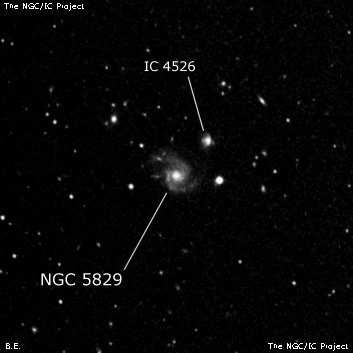
Édouard Stephan discovered NGC 5829 = St XII-68 on 11 May 1882. His position matches UGC 9673, the brightest member of HCG 73. The RA in the RNGC is 1.0 min of time too large. The UGC incorrectly equates IC 4526 with NGC 5829, but IC 4526 is a separate galaxy close northwest.
Edwin Hubble, in the 1920 published version of his PhD dissertation "Photographic Investigations of Faint Nebulae", noted IC 4526 is connected to NGC 5829. The two form a double nebula fashioned as a miniature of Messier 51.” That bridge is illusionary, though, as IC 4526 lies far in the background (redshift over twice that of NGC 5829) and there is no physical connection.
400/500mm - 17.5" (7/8/94): fairly faint, slightly elongated 4:3 E-W, 1.2'x0.9', very weak concentration, irregular or mottled surface brightness. Located between a mag 11.5 star just off the west edge 1.2' from center and a mag 13.5 star 1.3' ESE of center. This is the brightest member of HCG 73.
600/800mm - 24" (7/11/18): at 225x; fairly faint to moderately bright, irregularly round, very small brighter core, low surface brightness halo, ~0.8'x0.6'. A mag 12.4 star is 1.2' W, a mag 14.5 star 1.3' ESE and a mag 16.2 star is 1.3' NE.
Two other members of HCG 73 were visible; IC 4526 1.4' NW and HCG 73C 2.4' NE. The latter galaxy appeared extremely faint and small, 10" diameter. The mag 16.2 star is at the midpoint of NGC 5829 and HCG 73C.
900/1200mm - 48" (5/3/19): at 375x; fairly bright, large, slightly elongated, 1.2'x1.0', well concentrated with a relatively large brighter core. A bright mag 12.4 star is 1.2' W. NGC 5829 is the brightest of 5 in the HCG 73 quintet with IC 4526 1.4' NW, HCG 73C 2.4' NE, HCG 73D 3.3' NW and HCG 73E 2.5' WSW. HCG 73E lies in the background.
73C: fairly faint, very small, round, 12" diameter, very small bright nucleus.
73D: nearly fairly faint, small, very elongated 3:1 SW-NE, 0.3'x0.1'.
73E: faint, very small, slightly elongated ~N-S, ~10"x7". Nearly visible continuously with averted vision.
Notes by Steve Gottlieb